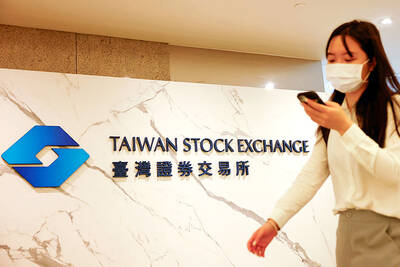The nation’s industrial production index rose by a better-than-expected 8.83 percent annually to 111.27 last month, driven mainly by the production of electronics components related to Apple Inc’s iPhone 7 sales, the Ministry of Economic Affairs said yesterday.
The growth not only exceeded the ministry’s estimate of 5 percent, but also marked the fifth straight month of annual increase, the ministry’s data showed.
However, industrial output in the first 11 months of this year rose a mild 0.95 percent from the same period last year, the data showed.
Manufacturing output, which accounted for more than 90 percent of industrial production, last month jumped 10.36 percent year-on-year, the largest increase since October 2014, the ministry’s data showed.
“Many market watchers had held a pessimistic view regarding the sales outlook of the iPhone 7, but statistics showed that export orders and the industrial output of iPhone-related sectors performed impressively over the past few months,” Department of Statistics Deputy Director-General Wang Shu-chuan (王淑娟) told a news conference.
For example, semiconductor production last month rose 37.64 percent annually on demand for communications chips used in smartphones and graphics chips for high-end gaming computers, Wang said.
However, production of computer electronics and optical goods contracted by 3.65 percent from a year ago, which Wang attributed to a Taiwanese smartphone brand’s falling output.
She declined to specify the company.
HTC Corp (宏達電) is the only Taiwanese manufacturer that produces smartphones domestically, at its Taoyuan plant, whereas other firms manufacture handsets offshore.
For this month, the ministry forecast that local manufacturers’ momentum would extend from last month, with an estimated increase in industrial production of 6 percent, as supply chains prepare for pre-Lunar New year inventory buildups, Wang said.
The Lunar New Year holiday is to run from Jan. 27 to Feb. 1.
Overall manufacturing output this year is expected to expand 1.7 percent annually, compared with last year’s annual drop of 1.49 percent.
In a separate news release, the ministry said that revenue of the wholesale sector rose 6 percent to NT$843 billion last month from the same period last year, due to positive market responses for smartphones, virtual-reality devices, TVs and gaming computers.
The retail sector benefited from Singles’ Day promotions and robust sales of imported vehicles, with revenue expanding 2.5 percent year-on-year to NT$357.8 billion, while revenue of the restaurant and beverage sector climbed 2.9 percent to NT$34.5 billion, Wang said.
Combined sales of the wholesale sector fell 2.3 percent annually in the January-to-November period, while the cumulative revenue of the retail sector rose 1.9 percent and the restaurant and beverage sector increased 3.4 percent.
Demand during the Christmas and Lunar New Year holidays is forecast to lift this month’s wholesale revenue by 2 percent annually, Wang said, adding that holiday shopping this month might boost retail and restaurant revenue by 4 percent and 3.4 percent respectively.

ADVANCED: Previously, Taiwanese chip companies were restricted from building overseas fabs with technology less than two generations behind domestic factories Taiwan Semiconductor Manufacturing Co (TSMC, 台積電), a major chip supplier to Nvidia Corp, would no longer be restricted from investing in next-generation 2-nanometer chip production in the US, the Ministry of Economic Affairs said yesterday. However, the ministry added that the world’s biggest contract chipmaker would not be making any reckless decisions, given the weight of its up to US$30 billion investment. To safeguard Taiwan’s chip technology advantages, the government has barred local chipmakers from making chips using more advanced technologies at their overseas factories, in China particularly. Chipmakers were previously only allowed to produce chips using less advanced technologies, specifically

The New Taiwan dollar is on the verge of overtaking the yuan as Asia’s best carry-trade target given its lower risk of interest-rate and currency volatility. A strategy of borrowing the New Taiwan dollar to invest in higher-yielding alternatives has generated the second-highest return over the past month among Asian currencies behind the yuan, based on the Sharpe ratio that measures risk-adjusted relative returns. The New Taiwan dollar may soon replace its Chinese peer as the region’s favored carry trade tool, analysts say, citing Beijing’s efforts to support the yuan that can create wild swings in borrowing costs. In contrast,

BRAVE NEW WORLD: Nvidia believes that AI would fuel a new industrial revolution and would ‘do whatever we can’ to guide US AI policy, CEO Jensen Huang said Nvidia Corp cofounder and chief executive officer Jensen Huang (黃仁勳) on Tuesday said he is ready to meet US president-elect Donald Trump and offer his help to the incoming administration. “I’d be delighted to go see him and congratulate him, and do whatever we can to make this administration succeed,” Huang said in an interview with Bloomberg Television, adding that he has not been invited to visit Trump’s home base at Mar-a-Lago in Florida yet. As head of the world’s most valuable chipmaker, Huang has an opportunity to help steer the administration’s artificial intelligence (AI) policy at a moment of rapid change.

TARIFF SURGE: The strong performance could be attributed to the growing artificial intelligence device market and mass orders ahead of potential US tariffs, analysts said The combined revenue of companies listed on the Taiwan Stock Exchange and the Taipei Exchange for the whole of last year totaled NT$44.66 trillion (US$1.35 trillion), up 12.8 percent year-on-year and hit a record high, data compiled by investment consulting firm CMoney showed on Saturday. The result came after listed firms reported a 23.92 percent annual increase in combined revenue for last month at NT$4.1 trillion, the second-highest for the month of December on record, and posted a 15.63 percent rise in combined revenue for the December quarter at NT$12.25 billion, the highest quarterly figure ever, the data showed. Analysts attributed the